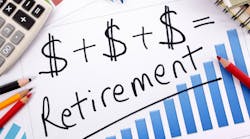Asset allocation for dentists: Getting your portfolio ready for retirement
Most retiring dentists have read an article or two on retirement planning for their investments, but have they ever really thought the process through for their particular needs? You’ve heard the old adage, “Plan early and often for retirement.” Even though it may seem light-years away, the day you begin to practice is the day you should start to make retirement decisions. Sadly, most dentists wait to invest five or six years from actually retiring.
When you begin to invest for retirement you need to put a diversified portfolio together that you are comfortable with, considering the volatility, etc., of the market. I recommend you do three things to adequately prepare for retirement: increase your knowledge, work with a qualified professional, and allocate your assets.
Why asset allocation is important
Remember that your choice of stocks and bonds—whether through buying mutual funds, Exchange Traded Funds (ETFs), or individual securities—is second from the choices you will make regarding the asset allocation.Asset allocationallows you to balance the risk and rewards of your portfolio to coincide with your goals and the investment horizon(s) you have chosen.
Few health professionals who retire give this more than lip service because they’re sure that their investing decisions will remain the same. Asset allocation should be the cornerstone on which you organize your portfolio for the many years you will have during retirement. It is a matter of choosing 1) the time you intend to hold the investment, 2) what a reasonable return should be, and 3) the ability to stick to your decisions when the market falters.
RELATED READING:Tax and retirement planning for 2017
‘Good debt:’ The power of combining leverage and retirement savings for dentists
The dos and don'ts of retirement planning
Increase your knowledge
There are two ways to learn about asset allocation. Forget your friendly broker until you’ve armed yourself with knowledge. Begin by reading enough about asset allocation so that you’re prepared for an in-depth discussion.
Visit a library or bookstore and ask for books about retirement, but only to get an overview. You shouldn’t necessarily follow the suggestions since books and articles don’t know you and your situation.
Here are a few books I think are excellent:
• “Asset Allocation” by Roger Gibson, now in its fifth edition, is a great place to start.
• “The Intelligent Asset Allocator,” by William Bernstein, is very good.
• “Level 3 Investing”by James B. Cloonan, founder of The American Association of Individual Investors, should be required reading for anyone.
Find a qualified professional
If you’re just starting out, I highly recommend you find a Certified Financial Planner (CFP) to provide you with professional help. If you’re nearing retirement, hopefully you already work with a CFP.
I’ve been working with dentists since 1980 and find it amazing that many dentists don’t engage a CFP for professional help. At a recent meeting with a group of dentists, a show of hands revealed that most of them used a brokerage house. If you’re at a point in your retirement planning where you can choose between a CFP and brokerage, avoid a brokerage house. CFPs won’t charge you the high commission fees or sales charges that come with the loaded funds recommended by brokerage houses.
Remember, a loaded fund is a mutual fund that comes with a built-in sales charge or commission. According to finance columnist Jane Bryant Quinn, any investor who buys a loaded fund will have to wait approximately 10 years to get to the same place that the same fund without the load would have gotten them.
Once you have a grasp of asset allocation and the different approaches of retirement planning, look for someone with a CFP designation or similar designation who has worked with many professionals to prepare them for retirement. Never forget to ask the “what’s in it for them?” question. Since fees can eat up profit, be sure to ask what the total fees are.
I was recently sent a portfolio, and the broker said that the total fees were 1.25%. What the broker failed to tell me was that the fees did not include the ongoing fees charged by the mutual funds. When I put those numbers into the equation, it totaled 1.89%. The bottom line is that I ask about all the fees, and so should you!
Allocate your assets
Many articles explain how important asset allocation is on performance. For example, Brinson, Hood, and Beebower wrote about this in 1986. Don’t be misled by believing that the often-quoted 93.6% of your portfolio’s return is due to your asset allocation. That number deals with the variation of returns. The actual return of your portfolio is 100% due to the asset allocation. Without getting into more details than we need here, just remember that 100% of your returns are going to come from how you allocate your assets.
Many authors suggest starting with 100% bonds and adding stocks each year to the portfolio. Magazines, books, and articles show various amounts of stocks and bonds as the portfolio to use. As you can see, there is no set rule. Even the experts don’t agree. It is important to understand that stocks will allow your portfolio to grow so you won’t run out of money when you retire.
So, how should you review your asset allocation? What is your current asset allocation? Here are several solutions to consider as your prepare your retirement portfolio:
1. Have enough money in “safe” investments. These investments include money markets, short-term bond funds, or other “safe” investments to stop the worrying process. Determine what enough money means to you as you plan. Is three years’ worth of money enough? The markets have only gone down and stayed down for four years twice in the last 100 years. But the worrying really starts when you finally retire, and after 30+ years there is suddenly no monthly income from the practice.
2. Consider an online bank account. One idea that many use as they prepare for retirement is to put money in online bank accounts such as Ally, Synchrony, and American Express. These accounts tend to pay more than money market funds at your bank or brokerage house, and they’re FDIC insured. They are currently paying in a range of 0.9% to 1.05% on their “high yield” savings. When the market drops you can use this money for your required minimum distribution (RMD) or other needs, and you won’t have to worry if the market is down for a year or two.
3. Favor stocks as you get older. Your mix of stocks and bonds should favor stocks as you get older. You shouldn’t allocate less than 60% of your money to stocks over the entire history of your retirement portfolio. Most research shows that having less than 60% in stocks over a long period of time may cost too much in growth. That’s something to consider since populations are living longer, and you might live 20 to 30 years or longer in retirement. For some, the amount of time spent in in retirement may be as long as they practiced.
Frankly, if you have three years of money in a safe place, and you should, then you should consider comprising your portfolio with 75% to 80% stock. The remaining 20% to 25% should be in bonds. I know some advocate 90% to 100% in stocks if you have that money set aside safely. But it has been my experience during the last 30 years of helping dentists achieve their financial goals that most are not comfortable having that much in the stock market.
For the most current practice management headlines, click here.
For the most current dental headlines, click here.
References
• Brinson, Hood, and Beebower. Determinants of Portfolio Performance. Financial Analysts Journal, July/August 1986. p.33-37
• Ibbotson R, Kaplan PC. Does Asset Allocation Policy Explain 40, 90, or 100 Percent of Performance? Financial Analysts Journal, January/February 2000. p.29-33
• Ibbotson RG. The Importance of Asset Allocation, Financial Analyst Journal. March/April 2010. p.18-20






